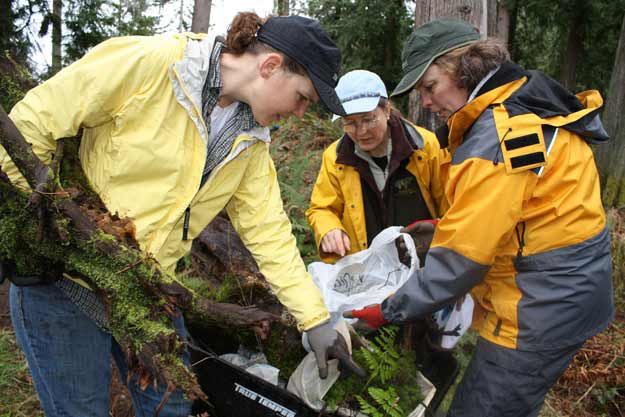Residents from around the area looking to give their garden a more Pacific Northwest look descended Sunday on the former WSU Demonstration Forest for a native plant salvage.
The Hall family, from Enumclaw, spent their morning in the forest, digging plants to help replace ground cover in their yard with local growth.
“We’ve got two-and-a-half acres and we want to make it look like it used to,” Doug Hall said.
According to Anna Thurston, volunteer program director for the Native Plant Salvage Alliance, the salvage was perfect for the Halls and anyone else looking to make their yards a little greener while saving a little green.
“Some of these plants you can’t get at the local big box stores,” she said. “And they’re preserving heritage; local, Washington heritage.”
Thurston and her group lead plant salvages throughout the region, taking groups into forests and prairies that are scheduled for development. The volunteers can then take the plants and transplant them to their own yards.
Thurston said adding native plants can help preserve habitats and require less work by gardeners because they evolved to live in the climates and environment instead of having to be cared for.
“We can achieve landscapes that require fewer chemicals and less water,” she said.
As Europeans settled in North America and spread across the continent, they brought many of the plant species with which they were familiar along with them to plant as food. Other plants, such as the Plantain (known as the “white man’s footprint”), piggybacked on settlers and spread across the world.
The native plants for which the Alliance are searching are those that pre-date settlement.
“It’s going to be a plant that is within a 3- to 30-mile radius and 500 feet elevation difference…that was growing in that habitat before Europeans settled in that area,” Thurston said.
Thurston said non-native plants can cause problems because they were not necessarily designed for the conditions in this area. She cites ivy as an example of a plant that not only smothers local plants, denying some animals their natural food sources and creating an “ivy desert,” but can also climb trees and create a “sail” that can catch wind and topple trees in a wind.
“It’s a big web and if you pull one thread a lot of others are going to wiggle along with it,” she said.
Thurston said, in any given area, the WSU forest is high quality. The group’s website calls it an “unusually weed-free and healthy urban habitat” which means finding native plants to salvage should be easier than some other locations, though she said even if it weren’t pristine, she would still lead a group into the forest.
“I’ll dig even when there’s weeds growing,” she said. “A lot of people are discovering native plants are pretty cool.”
For more information or to register for future events, visit www.ssstewardship.org.



